
With the introduction of public smoking bans in enclosed spaces, it has been argued that this may lead to more smoking in the home and therefore to increased secondhand smoke (SHS) exposure of non-smoking family members and children. This ‘displacement hypothesis’ puts forward that a consequence of smoke-free legislation would be an increase in SHS-related diseases.
The alternative, the ‘social diffusion hypothesis’, supports that changes in social norms due to public smoking bans may result in an increase in voluntary home smoking bans.
Children are particularly vulnerable to SHS as they are unable to protect themselves from exposure; an estimated 40–50% of children with smoking parents and/or other smoking household members are regularly exposed to SHS and therefore, the displacement hypothesis would have an especially deleterious effect on this population.
In the first systematic review to focus on children’s SHS exposure at home before and after the introduction of smoke-free legislations, based on conducting a meta-analysis of pooled relative risks, Sarah Nanning and colleagues at the University of Bremen, Germany, have looked at 15 studies which were published between 2007 and 2016. With the sample sizes ranging from 118 to 68,000 participants in the studies assessed, these all presented proportions of children (most aged between 5 and 15 years) exposed to SHS at home before and after the introduction of smoke-free legislation.
The findings of the study indicate that children’s SHS exposure at home did not increase after the introduction of public smoking bans. The comprehensive laws (those that require worksites, restaurants, and bars to be smoke-free) and mixed smoke-free laws (where there are regional differences in the type or extent of public smoking bans within a country or with an exceptional rule for certain types of hospitality venues such as small bars) yielded reductions of SHS exposure at home, whereby the effect was much greater in the group with mixed smoke-free laws. The authors therefore discredit the ‘social diffusion hypothesis’.

The results of the study must be interpreted with caution due to high heterogeneity between the publications assessed. Since only 15 articles were included in this analysis, additional studies are required to assess the impact of public smoking bans on children’s SHS exposure at home. Furthermore, as most of the studies had a short follow-up period, long-term studies on this topic using a greater variation of included countries are also required.
Comments